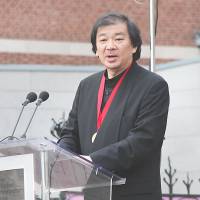Architect Shigeru Ban has formally accepted the 2014 Pritzker Prize with a vow to continue supporting people in stricken areas around the world, saying building designers have a responsibility to people caught up in disasters.
"An earthquake doesn't kill people, but the collapse of buildings kills people," Ban, 56, said in his speech, delivered in English, at the award ceremony Friday at the Amsterdam national museum.
"That is why I started working in the disaster area," he said, pledging to continue the efforts that won him the Pritzker Architecture Prize, often called the Nobel of architecture.
He was recognized not only for his unique architectural achievements, including the Centre Pompidou in Metz, France, but also his initiative to provide buildings and spaces using low-cost materials in places including Onagawa, Miyagi Prefecture, one of the towns worst hit by the magnitude-9.0 earthquake and tsunami on March 11, 2011.
"Historically, even now, we are working for privileged people who have money and power . . . but I think we should use our knowledge and experiences not only for privileged people, but also the general public, even people who lost their houses by natural disasters," he said at the award ceremony.
His humanitarian endeavors began with a proposal for a shelter made of cardboard tubes for people displaced in Rwanda in the 1990s. Following the 2011 earthquake in Christchurch, New Zealand, Ban built the Cardboard Cathedral as a symbol of the city's recovery. He has also helped those affected by major quakes in Japan.
He is the seventh Japanese to win the Pritzker, which was established in 1979. The prize is sponsored by a foundation run by the family that founded the Hyatt hotel chain in the United States.



